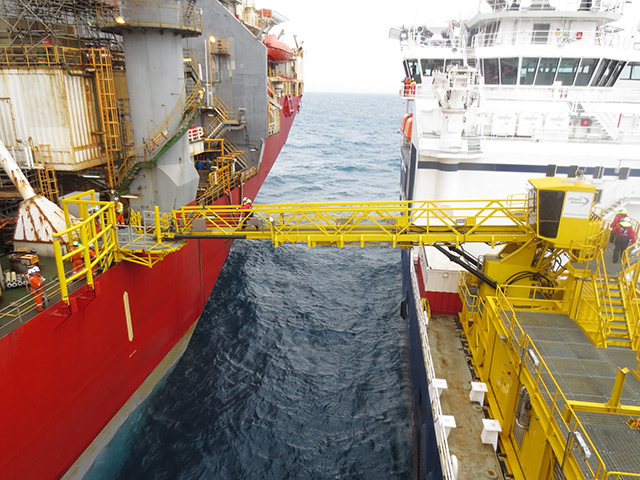
The use of walk to work systems in the North Sea has received a boost after another major oil company announced plans to use it.
Earlier this month we revealed that huge speedboats which could reach most platforms within two hours were being offered as a potential solution to the oil and gas industry’s helicopter crisis.
Dutch firm Ampelmann says it has been swamped with inquiries about its “walk to work” system – which allows workers to cross from boats on to platforms by foot – following last month’s Super Puma crash off Shetland.
Now it has emerged that Offshore Solutions BV (OSBV) – a joint venture between Amec and Cofely Nederland – has struck a deal to transport to the floating production, storage and offloading unit Global Producer III.
Located 185 miles north-east of Aberdeen, Scotland, OSBV’s offshore access system (OAS) will support the shutdown operations for a minimum of 110 days.
The walk to work system is deployed on the REM Installer, a new-build offshore subsea construction vessel chartered by Canyon Offshore, the marine contracting business unit of Helix Energy Solutions.
Sea trials for the project were completed in North Sea waters in July with operations starting later the same month.
Lindsay Young, managing director of OSBV, said: “OAS equipped vessels provide safe and cost effective marine transfer and offshore accommodation allowing for greater access to offshore installations than by crew vessels or helicopters. By using the OAS, additional offshore man-hours are made available, enhancing production whilst ensuring that workers are transported in a safe manner.
Boat transfers have been used by the industry when helicopters have been unable to fly.
They remain a last resort at present, due to the time it takes and the state it often leaves workers in.
Rob Armstrong, walk to work project manager for Maersk Oil UK, which is currently using the Global Producer, added: “Having personally investigated several walk to work options, the OAS proved to be the most reliable, with a track record of high connection rates and excellent operability.
“Maersk Oil UK undertook an intensive hazard identification procedure to select the safest system for the project and the OAS heave compensated marine access system that we examined complies with Maersk’s very stringent safety standards.”
Recommended for you
